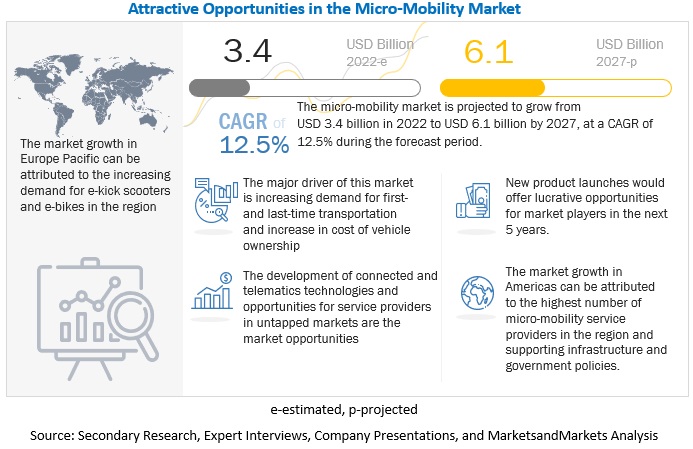The micro-mobility market is estimated to grow from USD 3.4 billion in 2022 to USD 6.1 billion by 2027 at a CAGR of 12.5% over the forecast period. Rapid urbanization, increasing cost of vehicle ownership and increasing demand of on-demand public transportation system in smart cities drive the development of the micro-mobility market during the forecast period.
There has been significant increase in population across the globe over the years. As the population increases there is need for public transportation across the cities for the commutation. Usually, the public transit local station stops are far from the home as well as from the work location, and people avoid using personal vehicles to travel such long distances due to traffic congestion, cost of vehicle ownership, rising gas and oil prices, rising insurance costs and lack of convenient parking.
Download PDF Brochure @ https://www.marketsandmarkets.com/pdfdownloadNew.asp?id=71389422
The passenger faces various problems regarding first mile and last mile transportation. In various countries such as US, Canada, Australia, New Zealand, and others most of the people are not comfortable walking more than 1 km distance. Micro-mobility is the best solution to fill the gap between first mile and last mile transportation need. Below mentioned factors are responsible for the growth of micro-mobility market across the globe.
The most vital driver for the development of micro-mobility is the rapid urbanization around the world. According to World Bank, most of the population living in cities has shifted to their countryside; still, the urbanization rate in 2021 was close to 56% globally, which was 55% in 2020. According to the World Health Organization (WHO), approximately 50% of the world’s population lives in urban areas, a proportion that is likely to increase to around 60% by 2025. According to World Bank, by 2045, the world’s urban population will increase by 1.5 times to 6 billion. The increasing number of cars used by a large section of this population has added to road traffic congestion and parking problems in urban areas. This has led to the rapid development of regularized public transport systems.
The rising urban population and increase in development of smart cities further increase the demand for on-demand public transport. Micro-mobility implementation is further driven by regulations and an emerging focus on smart city initiatives. According to the European Commission, the smart cities project market is expected to exceed USD 2 trillion by 2025, with Europe speculated to have the highest investment globally. With 12 cities in the region ranking among the top 25 in the world, Europe continues to be the best positioned geographical area for smart cities. Copenhagen, Amsterdam, London, Vienna, Paris, Barcelona, Stockholm, Berlin, and Helsinki have already initiated the development of smart city platforms. The complete transformation of these cities to smart cities is likely to occur gradually with projects in the next decade. Additionally, increasing urbanization will accentuate the need for better mobility services. Cities will continue with transformative changes to improve the quality of life by investing in urban mobility solutions. This would result in better transportation systems, which would continuously bring changes in transport policies.
Key Market Players:
The micro-mobility market is dominated by a few globally established companies such as Bird Global, Inc. (US), Lyft, Inc. (US), Lime (US), Helbiz Inc. (US), Dott (Netherlands). TIER (Germany), Bolt (Estonia), Voi (Sweden), and Veo (US).
Request Free Sample Report @ https://www.marketsandmarkets.com/requestsampleNew.asp?id=71389422
Media Contact
Company Name: MarketsandMarkets™ Research Private Ltd.
Contact Person: Mr. Aashish Mehra
Email: Send Email
Phone: 18886006441
Address:630 Dundee Road Suite 430
City: Northbrook
State: IL 60062
Country: United States
Website: https://www.marketsandmarkets.com/Market-Reports/laboratory-mixer-market-163287347.html

